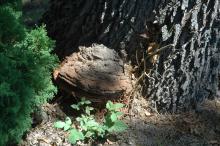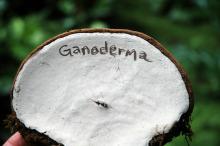Cause Ganoderma applanatum (formerly Fomes applanatus), also called the "Artist's conk," is a common root and butt rot fungus on oaks and other hardwoods, especially Oregon white oak. Decay is a white-mottled rot of the trunk and large roots. Decay can extend more than 10 feet above ground. Presence of conks indicates internal decay, but the extent of decay is difficult to determine from external indicators alone because it often is associated with wounds. Large conks usually indicate substantial internal decay. Decay in large roots and the lower bole increases the failure potential of the tree.
Wood decay fungi enter trees primarily through wounds that expose sapwood or heartwood. Injuries from pruning, sunburn, lightning, or cultivating equipment can expose susceptible wood. Large wounds and stub and horizontal cuts are often entry sites for decay fungi. Mycelial growth of the fungus proceeds with colonization and utilization of wood as a food source. Live trees are able to limit wood decay by walling off and compartmentalizing decay fungi but this can vary between different species and individuals. The CODIT model/principle (compartmentalization of decay in trees) is used by certified arborists to manage landscape trees with decay.
Symptoms Sparse foliage with limb dieback may be symptomatic but these are not consistently associated with the disease. Decay is a white-mottled rot of the trunk and large roots. Decay can extend more than 10 feet above ground. Perennial woody conks appear on the base of the tree or on trunk wounds. Conks are grey-to-brown on top, with a pure white underside (pore layer) that turns brown when scratched (spores are cinnamon in color). The bracket-shaped conks can achieve large size, over 2 feet in diameter.
Cultural control
- Avoid wounding trees to prevent decay. Mowing equipment should not injure the roots, crown, or lower trunk.
- Make pruning cuts adjacent to, but not into, the supporting branch, and prune when branches are small to enhance callus formation and wound healing.
- Inspect trees for decay and/or conks to assess tree stability
- Remove affected trees to avoid damage to surrounding property.
Reference Sinclair, W.A. and Lyon, H.H. 2005. Diseases of trees and shrubs, 2nd ed. Cornell University Press.



